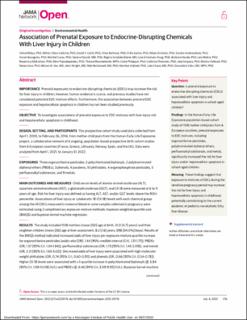| dc.description.abstract | Importance Prenatal exposures to endocrine-disrupting chemicals (EDCs) may increase the risk for liver injury in children; however, human evidence is scarce, and previous studies have not considered potential EDC-mixture effects. Furthermore, the association between prenatal EDC exposure and hepatocellular apoptosis in children has not been studied previously. Objective To investigate associations of prenatal exposure to EDC mixtures with liver injury risk and hepatocellular apoptosis in childhood. Design, Setting, and Participants This prospective cohort study used data collected from April 1, 2003, to February 26, 2016, from mother-child pairs from the Human Early-Life Exposome project, a collaborative network of 6 ongoing, population-based prospective birth cohort studies from 6 European countries (France, Greece, Lithuania, Norway, Spain, and the UK). Data were analyzed from April 1, 2021, to January 31, 2022. Exposures Three organochlorine pesticides, 5 polychlorinated biphenyls, 2 polybrominated diphenyl ethers (PBDEs), 3 phenols, 4 parabens, 10 phthalates, 4 organophosphate pesticides, 5 perfluoroalkyl substances, and 9 metals. Main Outcomes and Measures Child serum levels of alanine aminotransferase (ALT), aspartate aminotransferase (AST), γ-glutamyltransferase (GGT), and CK-18 were measured at 6 to 11 years of age. Risk for liver injury was defined as having ALT, AST, and/or GGT levels above the 90th percentile. Associations of liver injury or cytokeratin 18 (CK-18) levels with each chemical group among the 45 EDCs measured in maternal blood or urine samples collected in pregnancy were estimated using 2 complimentary exposure-mixture methods: bayesian weighted quantile sum (BWQS) and bayesian kernel machine regression. Results The study included 1108 mothers (mean [SD] age at birth, 31.0 [4.7] years) and their singleton children (mean [SD] age at liver assessment, 8.2 [1.6] years; 598 [54.0%] boys). Results of the BWQS method indicated increased odds of liver injury per exposure-mixture quartile increase for organochlorine pesticides (odds ratio [OR], 1.44 [95% credible interval (CrI), 1.21-1.71]), PBDEs (OR, 1.57 [95% CrI, 1.34-1.84]), perfluoroalkyl substances (OR, 1.73 [95% CrI, 1.45-2.09]), and metals (OR, 2.21 [95% CrI, 1.65-3.02]). Decreased odds of liver injury were associated with high-molecular-weight phthalates (OR, 0.74 [95% CrI, 0.60-0.91]) and phenols (OR, 0.66 [95% CrI, 0.54-0.78]). Higher CK-18 levels were associated with a 1-quartile increase in polychlorinated biphenyls (β, 5.84 [95% CrI, 1.69-10.08] IU/L) and PBDEs (β, 6.46 [95% CrI, 3.09-9.92] IU/L). Bayesian kernel machine regression showed associations in a similar direction as BWQS for all EDCs and a nonlinear association between phenols and CK-18 levels. Conclusions and Relevance With a combination of 2 state-of-the-art exposure-mixture approaches, consistent evidence suggests that prenatal exposures to EDCs are associated with higher risk for liver injury and CK-18 levels and constitute a potential risk factor for pediatric nonalcoholic fatty liver disease. | |
